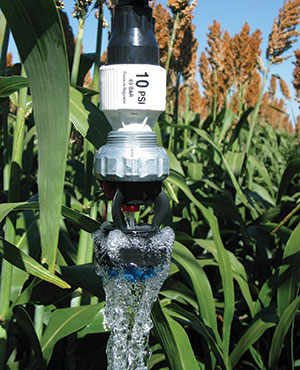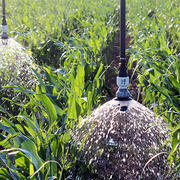
In the mid 80’s researchers at the Texas A&M Research & Extension Center worked with Senninger Irrigation to develop the first Low Energy Precision Application (LEPA) sprinkler.
Using LEPA bubble sprinklers close to the ground helped combat wind-drift and evaporation and helped them make the most out of the water they had.
A few years ago, North Texas growers looked at combining conservation tillage practices with LEPA heads but closing up the spacing. This distributes water over most of the soil surface increasing the application efficiency”.
The crop residue holds the water in place allowing it to soak in and fill the soil profile. Subsequent fewer irrigation cycles are required to keep water in the root zone to promote crop development. For growers, this means irrigation can be reduced from watering over a seven day cycle to watering over a two day cycle.
Growers now use strip-till and no-till switching their regular spray systems to LEPA bubble sprinklers, such as Senninger’s LDN® Bubbler Pad and LDN Shroud, and strategically placed the sprinklers closer together and low to the ground.
The Senninger double gooseneck combined with the Truss Rod Hose Sling facilitates precise spacing by creating two drops from one outlet. Growers saw significant water savings and increased yields and in fact, Texas NRCS has endorsed conversion of existing center pivots and linears to a Precision Application – Residue Managed (PARM) sprinklers which qualify for funding.
Weather patterns have created renewed interest in this type of irrigation practice in many areas of the US. In addition to Texas, now LEPA close spacing irrigation is effectively used in Arizona, Nevada, New Mexico, California, Kansas, Colorado and Idaho.
Growers are combining various components of this practice differently and achieving great success. They alter the spacing on the first few spans, combine spray application with bubble applications at various crop stages, vary the sprinkler height off the ground, and even alter the application rate by irrigation cycle. Numbers vary by soil type and crop but typically there are yield increases and yet a 20% water savings.
How do LEPA sprinklers irrigate?
Bubble heads use less energy than conventional sprinklers and can operate at lower flows anywhere from 0.27 to 21.18 gpm.
Senninger offers two types of bubble applicators:
The LDN Bubbler Pad deposits water straight down into furrows and distributes water in a narrow stream that avoids wetting the foliage. This aerated stream provides a cascade of bubbling water instead of a fine mist, so growers don’t have to worry about evaporation due to high temperatures and low humidity or strong winds blowing away fine droplets.
The LDN Shroud deflects water down in a wide dome-shaped pattern that gently distributes water without spraying. This type of bubble can be used on fields without furrows and on rolling terrains due to its less concentrated distribution pattern. The LDN Shroud is ideal for germination and low crop watering and for growers concerned about compaction of sensitive soils.
Sources
Published as “A Closer Look at Close Spacing.” Lindsay Corporation Blog. March 18, 2016.


